- Geopolitics
- Non State Actors
- Organised crime
- Intelligence School


The Turkistan Islamic Party (TIP) in China, Syria and Beyond
The aftermath of the crocus city hall attack in russia, danab: the ‘lightning’ brigades of somalia, ethio-somalia relations: somaliland deal and shifting alliances, el-sa’ka egyptian special forces, putin’s c.a.r. bargain: resources for regime survival, big safari: the us air force’s marriage with private acquisition.
1.0 Introduction:
In the world of military aviation, innovation and adaptability are essential to maintaining an edge over potential adversaries. The United States Air Force (USAF) has consistently pushed the boundaries of technology, and one program that has played a pivotal role in achieving this is the Big Safari program.
Founded in 1952, Big Safari has been at the forefront of the rapid acquisition and modification of aircraft, enabling the US Air Force to respond quickly to emerging threats and operational requirements. The purpose of Big Safari was to marry talent and technology from private industry with the US Air Force’s evolving portfolio of requirements during the Cold War.
Big Safari was very much a product of the contest between East and West. It gave birth to aircraft which are fascinating in their own right and have become household names. In this article, we will explore the success, development and controversies surrounding Big Safari.
2.0 Mottos, Symbols and Patches:
The following is a cursory overview of the mottos, symbols and patches associated with Big Safari. There are two variations of patches associated with Big Safari, one blue and one tan. The tan one is illustrated below.
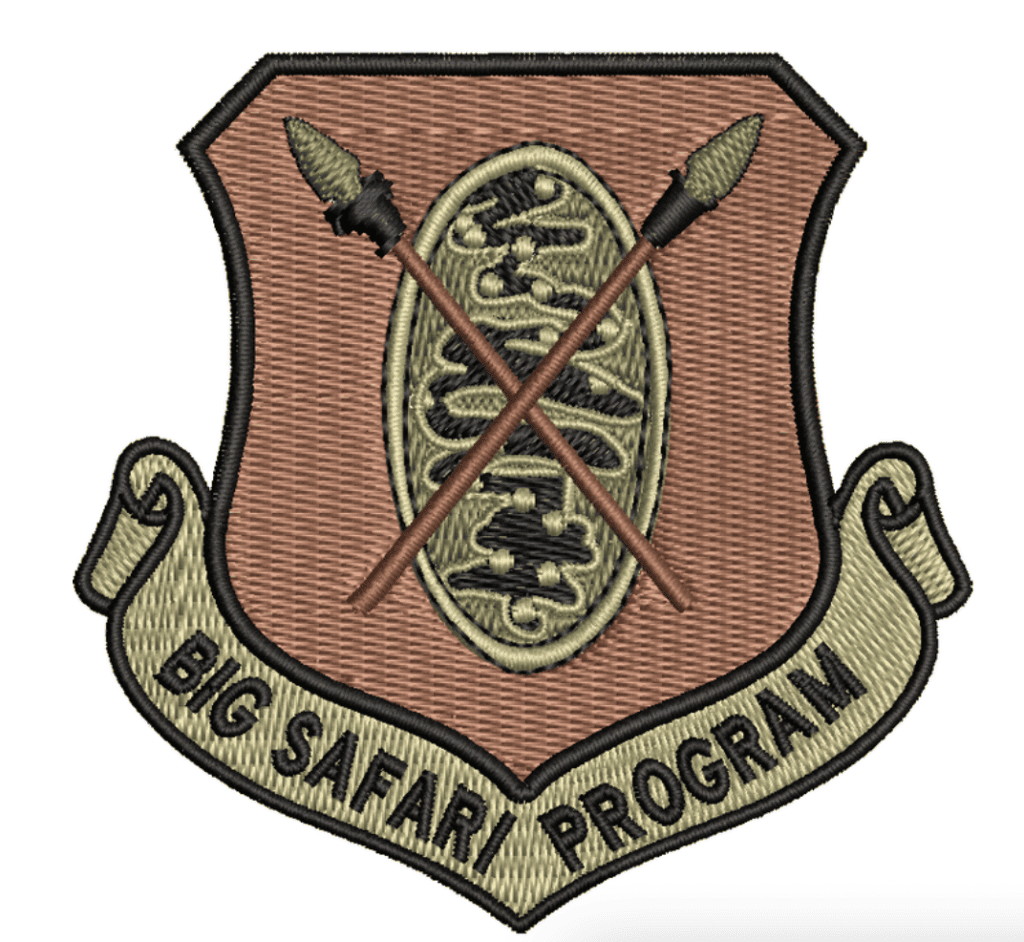
There is no official motto printed on the Big Safari patch. Overall, there is no official motto associated with Big Safari. After the program was reactivated in 2006 as the 645th Aeronautical Systems Group, the US Air Force still did not award the program a motto. The emblem was officially approved by the Pentagon in 2021 [ source ]. On top of this, there is no official explanation of the symbolism of the patch.
3.0 History:
In 1952, the United States found itself in an increasingly crowded threat environment. Although the fight against fascism led the United States into a brief partnership with the Soviet Union, the spirit of amicability dissipated rapidly. Soon, the USSR imposed an Iron Curtain across the breadth of Europe and the Korean Peninsula turned into a shooting gallery. The nucleus of what eventually became Big Safari began with USAF Brig. General Walter Wise [source]. General Lauris Norstad, then the commander of US Air Forces in Europe, found himself in need of an aircraft which didn’t exist. In order to peer across the Iron Curtain, General Norstad needed a totally new reconnaissance aircraft capable of performing intelligence-gathering capabilities. In order to quickly develop this new aircraft, Air Force Chief of Staff Hoyt Vandenberg convened a series of meetings with high-level Air Force officers to develop a system which would allow the Air Force to procure the needed systems to rapidly give birth to special projects. To quote one of the Air Force generals involved in the inception of the Big Safari program, George Rhodes:
“There wasn’t anything common with what we were doing. We sat down and said OK: if we are going to do this, the first thing we have to do is to have procurement procedures that permit us to designate the contractor”.
The need to quickly procure contractors for special projects was at the heart of Big Safari’s purpose from the very beginning. The effort was initially envisioned as a 5-year program [source]. Rhodes established 8 separate guidelines which would govern the procurement of contracts and acquisition of new technology. Two of these guidelines stand out above the others. The first was that was not to be any set limit to budgets. The second was that every special project would be closed off to general personnel of the USAF [ source ]. In early 1952, responsibility for carrying out these tasks fell to the Air Material Command, under which Big Safari was initially organized.

3.1 Later History and Reorganization:
The program was reorganized in 2004 and officially activated as a part of the 645th Aeronautical Systems Group in 2006 [ source ]. During its history, Big Safari went on to create the Rivet Joint program of reconnaissance aircraft and support ELINT, MASINT, IMINT and GEOINT intelligence collection efforts throughout the Cold War [source]. A major early contracting partner with the Big Safari program was Convair. Per Rhodes’ guidelines, all development took place at the Convair plant in Fort Worth from 1952 to 1961 [source]. Throughout the duration of these efforts, US Air Force personnel were absent from production efforts. Big Safari is probably the best example of private industry and military necessity for this reason. The Pentagon appears to have fully delegated the task of developing mission-critical aircraft. In this sense, it could very well be described as the origin of what President Eisenhower contemporaneously called the military-industrial complex.
4.0 Organization:
The Big Safari program was initially placed under the direction of the Air Material Command. The AMC was a major command of the newly formed USAF which handles the procurement, logistics and technical requirements of USAF aircraft. During the Kennedy Administration, the Department of Defense underwent a reorganization through a process similar to the Base Realignment and Closure (BRAC) system [ source ]. The AMC was split into the Air Force Logistics Command and the Air Force Systems Command. Big Safari worked closely onwards with Systems Command [ source ].
In 1992, these 2 commands were once again recombined into the AMC. Big Safari was eventually reactivated in 2005 after a hiatus of unknown length, though it is likely that the program was inactive from the late 1970s till the late 1980s [source]. It was in 2005 that Big Safari explicitly became the 645th Aeronautical Systems Group. The 645th is subordinated under the 303rd Aeronautical Systems Wing. Reportedly, the National Air and Space Intelligence Center provides a certain degree of input into the decision-making process at Big Safari [ source ].
5.0 Notable Aircraft:
There are literally hundreds of aircraft which were developed by Big Safari or received some degree of input from the program. They are too numerous to list in exhaustive form here. Rather, we will focus on a select number illustrating the program’s driving mantra. The program almost exclusively focused on reconnaissance and surveillance aircraft.
5.1 PIE FACE:
PIE FACE was the very first aircraft which fell under the Big Safari umbrella. The Air Force initially partnered with General Dynamics – Convair in order to streamline the procurement of aircraft for special ISR missions, and PIE FACE was the first dry run of this effort. What General Norstad realized in early 1951 was that the USAF’s ISR platforms were not well equipped to image East German and Soviet military formations and equipment moving into Berlin. While we do not know the specific limitations of the Air Force’s previous imaging equipment, given the nature of what was developed in PIE FACE, we can surmise that image resolution was far too poor for the purpose. The Air Force tasked an engineering team at Harvard University to develop a monster of a camera.
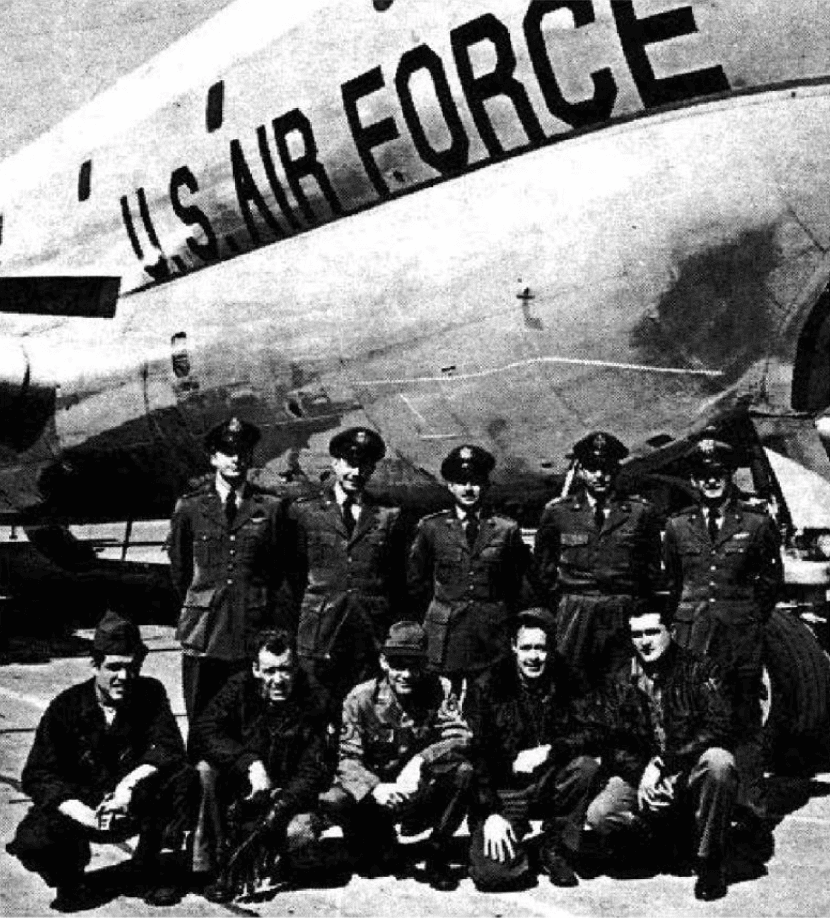
The team at Harvard developed a 20-foot-long camera lens, equipped with a pair of reflective mirrors and a huge F-8 lens. At the time, this was the largest camera installed in an aircraft [ source ]. A camera of that size would need a comparable airframe. The 2 units, known as Bertha and Betsy Mae, would come to use the largest roll of film ever ordered from Kodiak in the entire history of that company [ source ]. The only aircraft which was suitable at the time to host this immense array of optical equipment was the KC-97A. The aircraft was upgraded with structural modifications that could support the enormity of the camera. The PIE FACE aircraft was also equipped with 3 K-17 optical instruments [ source ]. PIE FACE went on to fly multiple ISR missions along the Berlin Air Corridor.
5.1 SARA JANE :
In 1954, Soviet premier Khrushchev visited the United States in an effort to thaw growing tensions and East-West rivalry [ source ]. American intelligence officials were reportedly convinced that Khrushchev’s Tu-114 was being used to photograph American military installations as it flew in [ source ]. Even if it was or was not true, it gave birth to the concept of SARA JANE. The idea was to convert C-54E VIP transport aircraft into ISR platforms that could fly over enemy installations in plain sight and under the guise of a diplomatic mission.
The entire project was obscured in an extra level of secrecy at Convair’s facility in Texas [ source ]. In total, 14 P2 cameras were fastened into the wings of the aircraft in fuel-tight pockets. These P2 cameras were complimented by a suite of additional lenses manufactured by Fairchild. Rather ingeniously, engineers added a mechanism that would dump fuel if the panels covering the cameras were removed. The design was designed to be totally covert, so much so that if if anyone ran an X-Ray over the wing, the mechanism would be hidden. The pilot was able to trigger pneumatic doors which covered the lenses from the cockpit, allowing the flight crew to activate the ISR suite at their discretion [ source ].
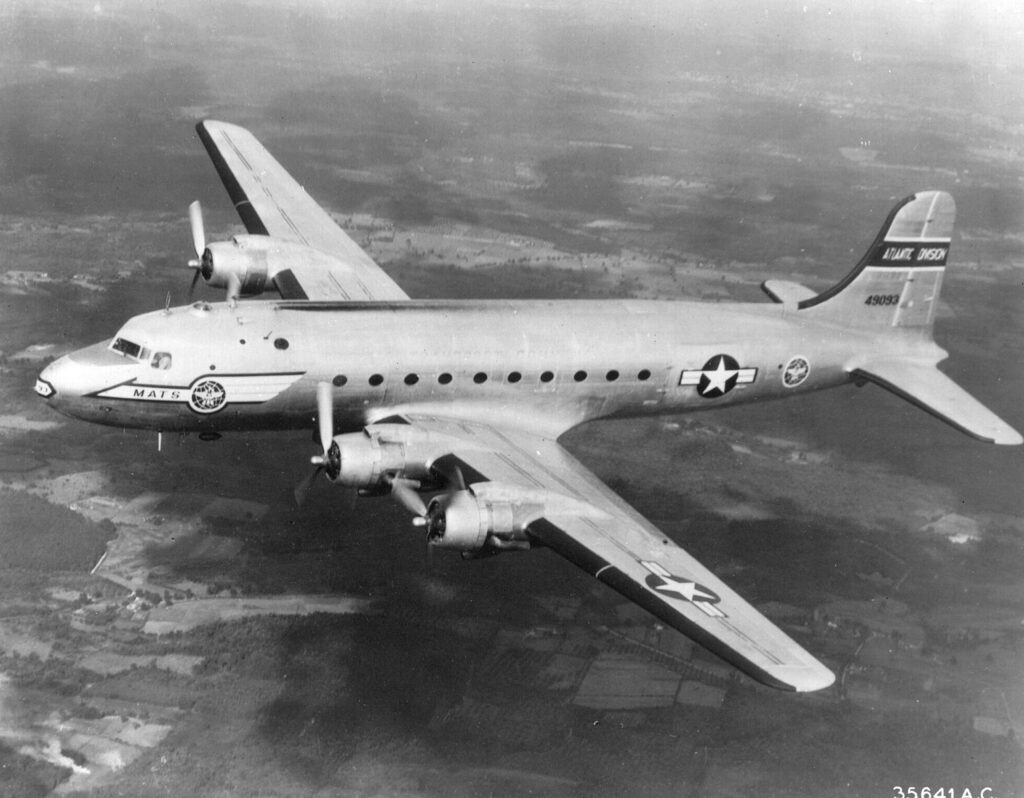
The two SARA JANE aircraft were stationed across West Germany and were probably utilized as Embassy support aircraft. One aircraft was used to fly supplies to the US Embassy in Moscow. According to retired USAF Colonel Dan Gareri, a Soviet officer accompanied the crew on this flight. By use of a covert inter-phone panel installed in the crew cabin, US personnel were able to secretly trigger the ISR suite without the knowledge of the Soviet minder [ source ].
5.2 NANCY RAE :
Beginning in the early 1960’s the need for large, heavy strategic bombers to deliver nuclear payloads over Soviet or American cities was beginning to wane. This was due in part to the addition of two new arms of the nuclear triad, submarine-launched ballistic missiles (SLBMs) and intercontinental ballistic missiles (ICBMs). Commensurate with that shift, however, was the growing need to monitor Soviet ICBM tests with highly advanced sensors aboard intelligence aircraft. NANCY RAE was an early attempt to fill this intelligence gap. The aircraft initially was an unmodified KC-135 which underwent extensive upgrades at the Big Safari facility in Texas [ source ].
The sensors aboard NANCY RAE can be broadly classified into 2 different varieties, optical sensors and ELINT sensors. These sensors would measure not only the trajectory and irradiance of the ICBM’s reentry but also ground communication from Soviet naval assets or ground forces. According to one crew member on NANCY RAE, the crew practically lived on the aircraft while it was deployed in Dakar, Senegal [ source ]. Col. Bill Grimes, a major figure in the Big Safari saga, was deployed on NANCY RAE during it’s later flights.
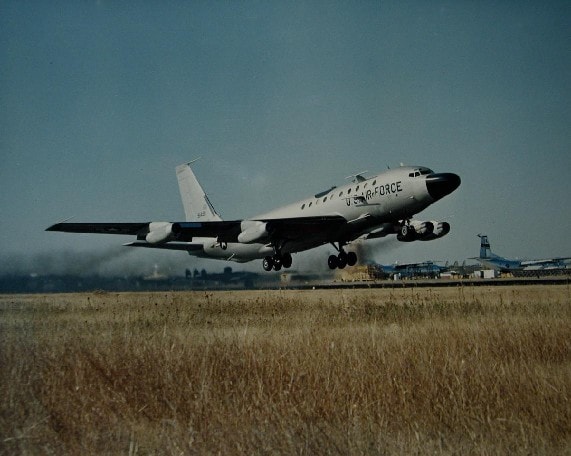
NANCY RAE had a prolific career. It’s 40-strong crew gained the title “Ali Baba and the 40 Thieves”. This name reflected the uncanny ability of NANCY RAE to grab sensitive Soviet communications. The aircraft’s mission profile was so successful that President Kennedy was given weekly briefings on the data gathered by the aircraft [ source ].
5.3 SPEED LIGHT BRAVO:
SPEED LIGHT BRAVO provides an excellent glimpse into exactly why the Big Safari program existed in the first place. On 9 August 1964, Soviet Premier Nikita Khrushchev issued an alarming proclamation. He asserted that the USSR was fully capable of building and detonating a 100-megaton nuclear bomb. This was a shocking amount of destructive firepower. In order to prove his claim, he announced that the USSR would conduct a test of a warhead at a 50-megaton yield. Reportedly, this announcement caught the immediate attention of researchers at the Los Alamos Laboratory in New Mexico [ source ].
The team at Los Alamos had a sensor array capable of monitoring the gigantic explosion, but no suitable aircraft to carry it close to the detonation site. A request was put in with Fort Worth and Big Safari to load this sensor array onto a JKC-135A. This particular aircraft had been outfitted with lead lining in limited areas, making it suitable to monitor the single largest explosion in human history [ source ].
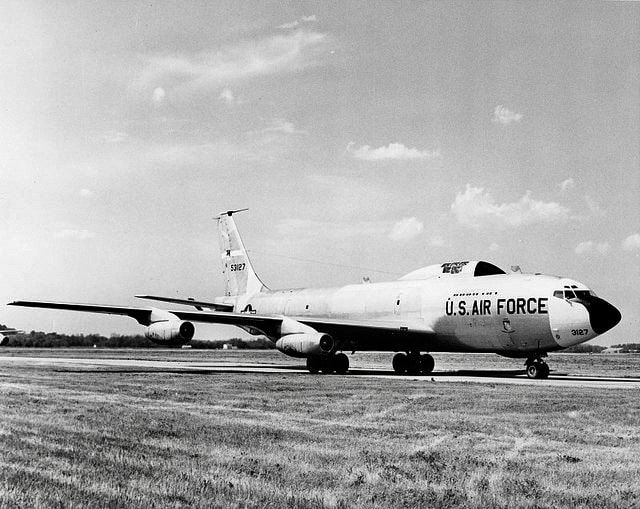
Between 22 and 27 October, 1964, SPEED LIGHT BRAVO was received and outfitted with the relevant sensors, a mere 5 days [ source ]. This is probably the best example which highlights the purpose of the Big Safari program. A team of researchers identified a need. The military stepped into the connect their technology with a private contractor, in this case Convair, and the contractor delivered a finished product in less than a week. Reportedly, the Air Force was told to push the project through and deal with the paper work later [ source ].
On 30 October, a Soviet Tu-95 bomber dropped a nuclear payload over Sukhoy Nos on Severny Island. This payload was dubbed BIG IVAN, but it is better known as the Tsar Bomba. The device was intentionally blunted so that it would only detonate at 50 megatons. The detonation was so massive that the nuclear blast created a shockwave the repelled against the earth, such that the fireball never actually reached the ground [ source ]. SPEED LIGHT BRAVO was damaged by the sheer heat of the event and totally irradiated, although the crew appeared to be unaffected by the extreme radiation [ source ]. Nevertheless, the aircraft was eventually scrapped after it was deemed un-airworthy. SPEED LIGHT BRAVO unintentionally flew far to close to the blast zone [ source ].

5.4 PEE WEE 1-3:
The PEE WEE program stands out amongst other Big Safari endeavors due to the close cooperation of the Pakistani Air Force in it’s implementation. Originally a set of B-57 Canberra bombers, these aircraft played a vital role in surveillance of Soviet missile launches out of Kaputsin Yar. The US Navy had a poor track record of honoring commitments made to Pakistan and India, repeatedly crossing over into restricted airspaces of either country. Accordingly, Islamabad told the US Navy it was no longer welcome in Peshawar [ source ].
After a series of discussions with the Pakistani’s, the United States ultimately came into a comprised arrangement. Pakistan would allow for the resumption of intelligence gathering air operations with aircraft piloted by Pakistani officers. Moreover, the Pakistani’s would be responsible for the upkeep of the aircraft [ source ]. The bomb bay of the aircraft was fitted out with a sensor capable of receiving missile telemetry and the nose cone was elongated to accommodate a dual set of phased array S-band antennae [ source ]. Sensors were installed for radiation detection [ source ]. PEE WEE I and PEE WEE II were operational for little more than a year until the introduction of PEE WEE III.
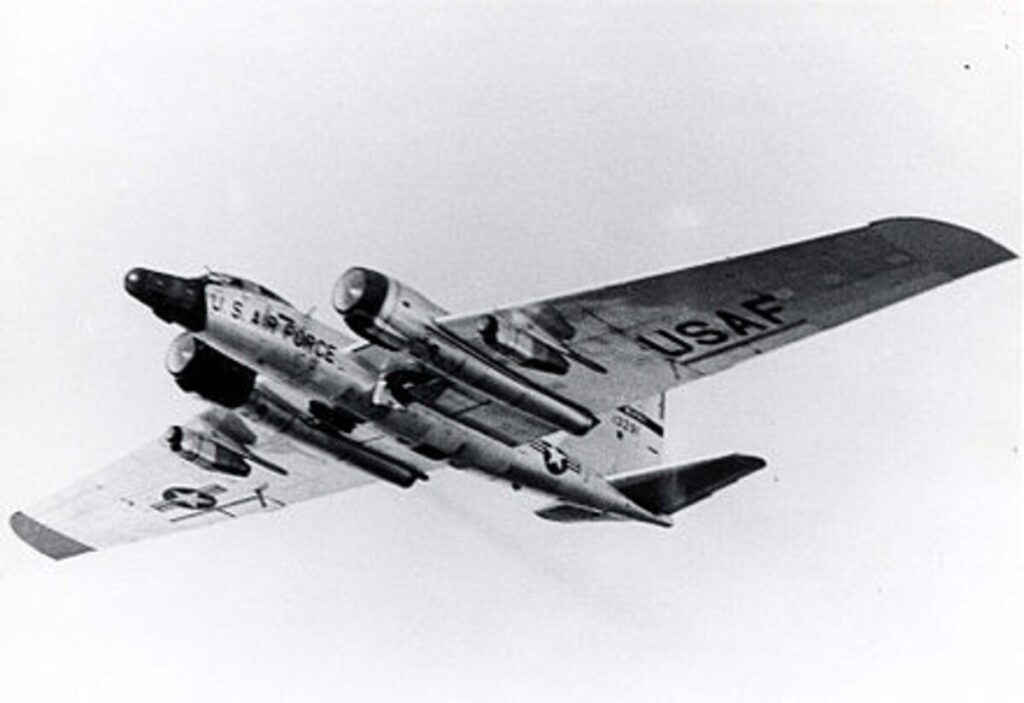
When the USSR shot down Gary Powers and his U-2 spy plane in 1960, President Eisenhower instituted a moratorium on high-altitude reconnaissance flights over the Soviet Union. PEE WEE III attempted to reinstate that mission profile. PEE WEE III was a complete redesign of the B-57’s airframe. The wingspan was doubled to an impressive 121 feet. Two additional engines were added, a set of Pratt and Whitney TF-33-P-11 Turbofan engines. These were far more powerful than the previous Wright J-65 Turbojets. To complement this increased power, two Pratt and Whitney air-started J60-P-9 turbojets were mounted under each wing and could be detached from the cockpit [source]. In addition to this, the cockpit was modified to fit two crew members wearing purpose-built pressurized suits to sustain the crew at high altitudes. A newer ejection seat system was also installed. Because of the high importance that this program entailed, Big Safari was given free rein to avoid cumbersome regulations and bureaucratic fancies to finish the aircraft on time [ source ].
Alongside Soviet missile tests, it is probable that PEE WEE aircraft were used to collect intelligence on Chinese nuclear activities as well. At least one PEE WEE III aircraft was significantly damaged during the 1965 Indo-Pakistani War [ source ].
5.5 RIVET DIGGER:
With the introduction of the Limited Test Ban Treaty in August of 1963, the global environment was given a respite from the deleterious effects of atmospheric nuclear testing. However, Cold War paranoias meant that the United States never fully trusted the Soviet Union to adhere to the terms of the treaty. The ‘Readiness Program’ was started in order to rapidly re-activate nuclear test monitoring aircraft if the Soviet Union decided to violate the terms of the treaty. The EARLY DAY/RIVET DIGGER aircraft were the answer to that need.
Three NC-135A aircraft were set aside for the project. Each was ‘sponsored’ by a different scientific organization. Overall, the KC-135 family of aircraft has undergone numerous modifications and adaptations to fulfil a wide range of specialized roles [source]. These variants have showcased the platform’s flexibility and longevity, allowing it to remain a vital asset in military operations, aerial refuelling, intelligence gathering, and experimental research. RIVET DIGGER probably stands out amongst all of the other variants due to its bizarre features. The aircraft was crewed by personnel from the Air Force Special Weapons Center but complemented by a scientific contingent from each of the sponsoring scientific bodies. Evidently, military personnel found it difficult to manage the larger-than-life egos of the science teams from Lawrence Livermore, Los Alamos and Sandia National Laboratories [ source ].
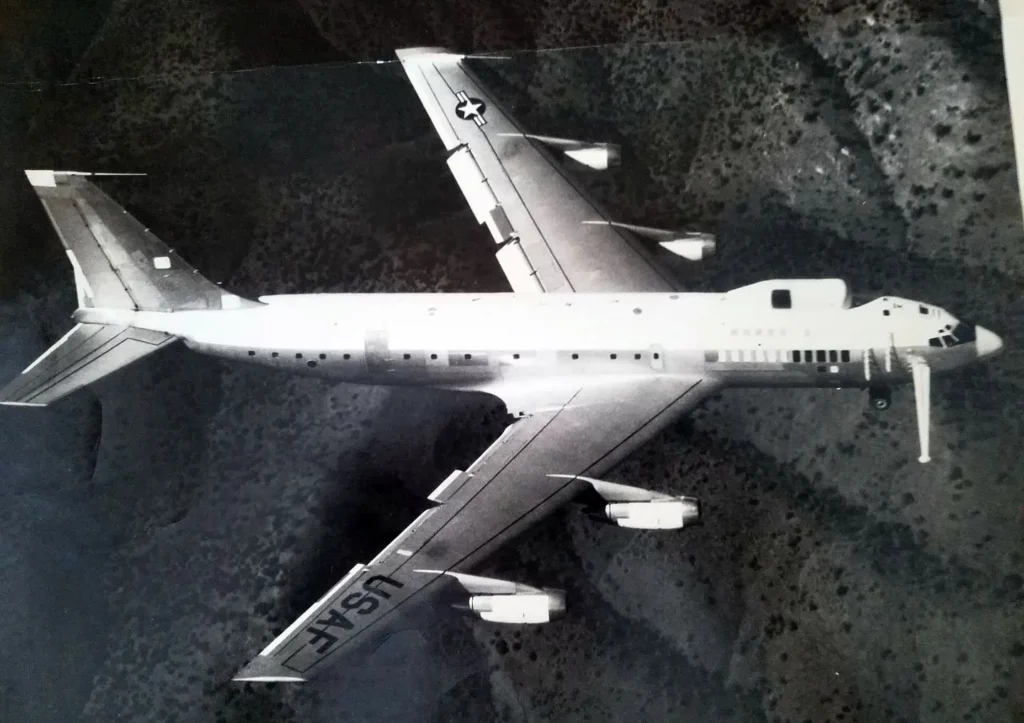
These aircraft were designed to conduct intelligence gathering on atmospheric nuclear tests, but when they were not used in that capacity, they were deployed for scientific data collection flights. These induced studying solar eclipses and cosmic rays [ source ].
6.0 Phoenix Ghost UAV
This April, the White House officially announced the existence of a new UAV during an announcement of a new aid package to the Ukrainian military. Among the various items, the US was sending 120 Phoenix Ghost suicide drones. Likely very similar to the Switchblade UAV, the Phoenix Ghost is reported to have a certain degree of ISR capabilities. The entire project was managed and sourced through Big Safari [ source ].
The Ukrainians have already begun intensive training with the platform and it’s possible that the system has already been deployed in the Donbas [ source ]. It is still too early to truly assess the impact of this new UAS, but the public will almost certainly be able to catch even a cursory glimpse of its performance in Ukraine given the shower of information and media which is posted online regularly.
7.0 Big Safari and L3 Harris:
Big Safari initially started out with a special relationship with General Dynamics – Convair. Over time, relationships have shifted. Currently, one of Big Safari’s major partners is L3 Harris. This relationship has not been without a degree of turbulence. The Inspector General of the Department of Defense has investigated L3 over the transfer of ISR platforms to the Kenyan government [ source ].
In 2017, L3 and Big Safari came under intense scrutiny from two GOP members of the House of Representatives. According to two USAF Majors, L3 was awarded a contract for the sale of aircraft to Yemen at an excess of $15 million more than the next competitor, IOMAX in 2014 [ source ]. In the case of the Pentagon’s Inspector General’s investigation, it was alleged that L3 was awarded a contract to manufacture border security aircraft for the Kenyan government despite having little to no experience in actually designing or manufacturing aircraft to the required specifications [ source ].
8.0 Other Controversies:
While the US Air Force’s Big Safari program has been lauded for its contributions to the rapid acquisition and modification of aircraft, there have been some controversies associated with the program. These controversies mainly revolve around issues such as cost overruns, lack of transparency, and concerns about accountability. Here are some of the controversies surrounding Big Safari:
Budgetary Concerns: One of the primary controversies surrounding Big Safari is the issue of cost overruns. Critics argue that the program has experienced significant budgetary challenges, with projects exceeding initial estimates and timelines. This has led to increased scrutiny of the program’s financial management and calls for improved cost-control measures. For example, a contract went to L3 over IOMAX, $15 million above IOMAX’s stated price [ source ].
Lack of Transparency: Some critics have raised concerns about the lack of transparency surrounding the Big Safari program. As it operates in a classified environment, there is limited public visibility into the program’s activities, decision-making processes, and project outcomes. This lack of transparency has led to questions about accountability and the potential for misuse of resources [ source ].
Contracting Practices: The contracting practices associated with Big Safari have also faced scrutiny. Critics argue that the program relies heavily on sole-source contracts, limiting competition and potentially resulting in higher costs. There have been calls for greater competition and increased oversight to ensure fairness and efficiency in the acquisition process [ source ].
Impact on Traditional Acquisition Programs: Another controversy arises from the perception that Big Safari’s rapid acquisition and modification capabilities may divert resources and attention from traditional acquisition programs. Some argue that the focus on quick solutions through Big Safari may hinder the development of long-term, sustainable systems and technologies [ source ].
Ethical Considerations: The nature of Big Safari’s operations, often involving sensitive technologies and classified information, raises ethical considerations. Critics question the program’s adherence to legal and ethical standards in areas such as privacy, data collection, and potential implications for international norms, agreements and the laws of war [ source ], [ source ].
Congressional Oversight: Controversies surrounding Big Safari have prompted increased congressional oversight. Lawmakers have called for more rigorous monitoring, accountability, and reporting on the program’s activities to ensure proper use of taxpayer funds and alignment with national defence priorities [ source ].
It is important to note that the controversies surrounding Big Safari should be viewed in the context of the program’s mission and the challenging nature of rapidly acquiring and modifying aircraft in a dynamic operational environment.
9.0 Conclusion:
The history of the US Air Force’s Big Safari program is one of continuous innovation, adaptation, and collaboration. From its early focus on electronic reconnaissance to its involvement in developing stealth aircraft and supporting special operations, Big Safari has consistently pushed the boundaries of airborne capabilities. By bridging the gap between traditional acquisition processes and operational needs, the program has played a pivotal role in ensuring the US Air Force remains at the forefront of airborne innovation and rapid acquisition capabilities. Very recently, the US Space Force announced the establishment of the ‘Space Safari’ program through the Space and Missile Systems Center Special Programs Directorate. Space Safari will play the exact same role as Big Safari for USSPACECOM [ source ].
These partnerships demonstrate the importance of collaboration between the US Air Force and industry leaders in driving innovation, leveraging expertise, and delivering cutting-edge capabilities for the Big Safari program. By combining the resources and knowledge of these partners, the USAF can rapidly respond to emerging operational requirements and maintain a technological edge in the ever-evolving landscape of military aviation.

Table of contents
Get the weekly email from Grey Dynamics that makes reading intel articles and reports actually enjoyable. Join our mailing list to stay in the loop for free!
Related contents
Grey Dynamics is an Intelligence firm based out of London with a network of analysts, researchers, and investigators worldwide.
- Privacy Policy
- Terms & Conditions
- USAF retires final ‘Big Safari’ NC-135W to the Boneyard

The USAF recently retired its last Pratt & Whitney TF33 turbofan-powered NC-135W Stratolifter test aircraft after more than 50 years of operational service.
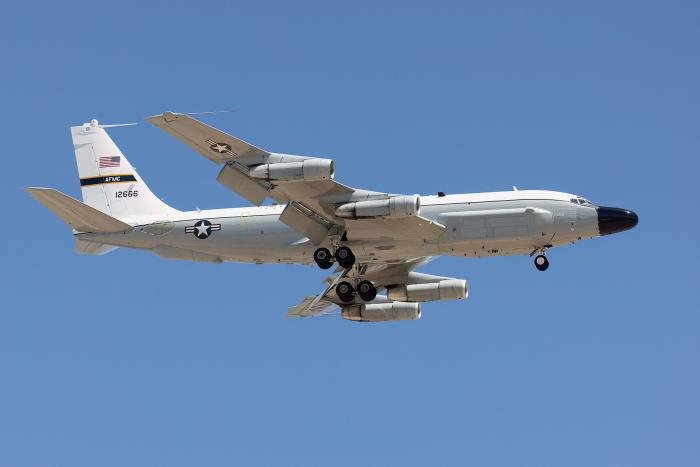
The NC-135W (61-2666) was flown from Greenville Municipal Airport-Majors Field in Texas – which is home to a L3Harris Mission Integration Division (MID) aircraft modification facility – to the famous Boneyard at Davis-Monthan AFB , Arizona, where it will be placed in long-term storage with the 309th Aerospace Maintenance and Regeneration Group (AMARG) – on September 5. This final Stratolifter had been operated by the 645th Aeronautical Systems Squadron, with the aircraft serving as a Big Safari testbed for the USAF’s fleet of RC-135V/W Rivet Joint intelligence-gathering aircraft.
This aircraft initially entered operational USAF service under the C-135B designation on March 30, 1962. It was later modified to WC-135B/W-standard to undertake weather reconnaissance operations, before the aircraft assumed its current NC-135W designation for the Big Safari mission in 1999. The NC-135W has been replaced in the Big Safari role by a single TC-135W (62-4133), which arrived at the L3Harris facility in Greenville in February 2023.
- United States (US)
- US Air Force (USAF)
- Boeing NC-135
- Davis-Monthan AFB
- 309th AMARG

Originally published in Key.Aero
Become a premium member.
Subscribe to Key.Aero now to enjoy great benefits:
- Access a wealth of aviation content in one place
- Support world-class journalism
- Join a community of passionate aviation enthusiasts
- All completely ad free!
Subscribe to Key.Aero now
Related articles
- Caravan Deliveries Begin
- Indonesia receives second new-build NC212i transport
- Initial NC-212i deliveries to Vietnam
- USAF's Big Safari Program receives TC-135W, prepares to divest last NC-135W
Get the Key.Aero newsletter
Receive exclusive content, offers, competitions and more.

LMAG - Big Safari - US Air Force Fast Intervention Program
Big Safari: US Air Force Fast Intervention Program
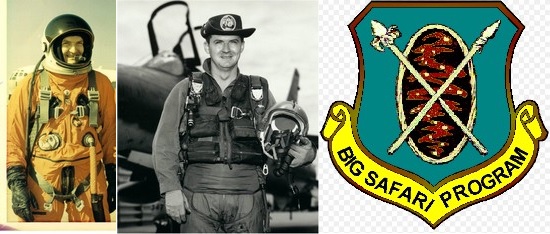
New Location this Month: CLU Overton Hall ( map )
Abstract For more than 50 years, Big Safari aircraft have performed dangerous and essential missions to collect intelligence, conduct surveillance and reconnaissance, and engage in special operations missions around the globe in the interest of national security. Big Safari represents a system designed for fast intervention that focuses on providing quick access to resources, efficient contracting engagements with suppliers and streamlined processes and distribution methods. Key personnel are trained for most efficient interventions. Jerry Knotts served 24 years in the US Air Force (USAF) and was a team member of the USAF Big Safari Program.
About the Speaker Colonel Jerry E. Knotts (Ret.) was fourteen years in the Big Safari special reconnaissance program at General Dynamics in Fort Worth, Texas; E-Systems in Greenville, Texas; and Lockheed Aircraft Services in Ontario, California. Jerry was responsible for creating and flight testing a number of specially configured aircraft, including the Combat Sent, Combat Talon, Cobra Ball, Rivet Joint and many others. During 1968, he completed 112 missions over North Vietnam in an F-105 Wild Weasel.
Jerry retired from the Air Force with 24 years of service. His last assignment was as commander of the Washington Area Contracting Center at Andrews Air Force Base. He was responsible for Air Force procurement throughout the Nation's Capital, and a region from the Azores to Saint Louis, His responsibilities included the White House and the Presidential VIP aircraft fleet that included the aircraft now in the Ronald Reagan Presidential Library Hanger.
For his outstanding service to our nation, Jerry received the Legion of Merit, Distinguished Flying Cross, Meritorious Service Medal with two oak leaf clusters, Air Medal with 13 oak leaf clusters, and the Air Force Commendation Medal.
For his remarkable public service, Jerry has received numerous awards. In 1996 he was honored by the Conejo Valley Historical Society. That same year, Jerry and his wife, Mary, both received the William E. Hamm Award from the California Lutheran University Community Leaders Club. Jerry also has been honored for his community service by having a seat designated in his name in the Thousand Oaks Civic Center Forum Theater. He previously received the Outstanding Service Award and the Silver Patrick Henry Medal from the Military Order of the World Wars.
Since retirement from the USAF, Jerry Knotts has been a serial entrepreneur, coach, angel investor and has worked with numerous entrepreneurs for over 30 years. Over this period of time, he started five companies and mentored over 400 start-ups.
Currently, Jerry is President, California Coast Venture Forum, Inc.( www.ccvf.org ), parent of the Clean Business Investment Summit and Chairman, Entrepreneurs Without Borders. He serves as mentor/screener for SoCalBio and the LARTA Institute wherein he supports DARPA, NSF, and the NIH-CAP (National Institute of Health - Commercialization Assistance Program). As treasurer, Youth Enrichment Foundation, Alexandria, VA, he supports 28 Youth Leadership Conferences throughout the country. He is also Executive Secretary, Society of Wild Weasels and board member/Treasurer of the Air Warrior Courage Foundation (AWCF) / Wounded Warriors Emergency Support Fund that supports wounded warriors in areas not covered by government programs.
He is a member, Dean's Board of Advisors, California Lutheran University (CLU) School of Management, a mentor with CLU, UCLA, UCSF, Auburn, Penn State, CSUCI and UCSB Entrepreneur programs and a panel member for the Goldman Sachs 10,000 Businesses Program at LACC and LBCC. His previous executive positions included Vice-President/General Manager, Government Electronics Division, California Microwave Inc. (CMI), Woodland Hills, CA; and Vice-President, American Nucleonics Corporation (ANC), Westlake Village, CA. These two companies provided specialized airborne electronic reconnaissance systems.
Jerry holds a BSEE (Electrical Engineering) from The Pennsylvania State University; and an MBA from Auburn University. In addition, he is a graduate of the Defense Acquisition University, Industrial College of the Armed Forces, Air Command and Staff College, and Air War College. He is a Senior Life Member of the Institute of Electrical and Electronic Engineers (IEEE); Chairman, IEEE Buenaventura Life Member Affinity Group, and past Secretary, IEEE Buenaventura Section. Jerry is a pilot, licensed Registered Professional Engineer (PE), Amateur Radio operator (K3ZZO) and life member of the Texas, California, and National Society of Professional Engineers. He is also a life member of both the Red River Valley Fighter Pilots Association (River Rats) and the Society of Wild Weasels.
Agenda Pizza and Networking: 6:30 PM Presentation: 7:00 PM
New Location CLU - Overton Hall California Lutheran University 3163 Regent Avenue Thousand Oaks, CA 91360 ( map )
Parking: Visitors may park on CLU streets after 7 PM without a permit. Before 7 PM, we recommend that you park in the G1 visitor lot on the southwest corner of Olsen and Mountclef, and walk to Overton Hall. Do not park in the faculty/staff/reserved lots.
Presented By: IEEE Buenaventura Aerospace and Electronic Systems Society Chapter
Date and Time
location, hosts, registration.
- Date: 15 Feb 2018
- Time: 06:30 PM to 08:30 PM
- All times are (GMT-08:00) US/Pacific

- 130 Overton Court
- Thousand Oaks , California
- United States 91360
- Building: Gilbert Sports and Fitness Center, 2nd Floor
- Room Number: 253
- Contact Event Host
- View history
Big Safari is a United States Air Force program which provides management, direction, and control of the acquisition, modification, and logistics support for special purpose weapons systems. The program itself receives some direction from National Air and Space Intelligence Center (NASIC). [1] It is headquartered in Wright-Patterson AFB and has facilities at Hanscom AFB and Greenville, Texas. The program oversees, among other aircraft, the RC-135 and EC-130 aircraft as well as unmanned aerial vehicles . The Air Force has referred to Big Safari as a "rapid procurement force," which tests the fielding of new weapons systems, sensors, and platforms. By some accounts, [2] the program has been operating since the late-1950s, when the BQM-34 Firefly drone was procured and evaluated. This effort led to the first operational unmanned reconnaissance vehicle, the redesignated Ryan Aeronautical AQM-34 Lightning Bug .
The program is still operational as of 2013. [3]
External links [ ]
- BIG SAFARI for National Defense Industrial Association (NDIA)
- The History of BIG SAFARI , by Col. Bill Grimes, USAF (Ret) ISBN 978-1480804562
References [ ]
- ↑ http://webapp1.dlib.indiana.edu/virtual_disk_library/index.cgi/821003/FID177/pubs/af/38/afpam38-102/afpam38-102.pdf
- ↑ https://research.maxwell.af.mil/papers/ay1997/acsc/97-0230D.pdf
- ↑ Reference to Big Safari as overseeing 'More Capable Predator' in AWST 21 Dec 2011
Col William D. W. (Bill) Grimes
Colonel William D. W. (Bill) Grimes (ret) , passed away on August 10, 2018 after a brief illness. He is known first and foremost as a loving husband to his wife, Judy (Darling) whom he described as the love of his life. They fell in love at first sight while in college and shared a passion for traveling (to six out of seven continents), genealogy, gardening, their dogs and the Cincinnati Bengals. Beloved father of Bonnie (Donald) Schutte, Erika Grimes and Valerie (Brook) Ratcliff, sweet ole Bill is remembered for his love of fishing, hunting, jigsaw puzzles and practical jokes, his hard work ethic, amazing woodworking skills, and passion to take family trips to every Civil War battlefield. He adored his grandchildren Summer, Christina, Ariel and Zeke Halford whom he Skyped weekly to Australia. Son of William and Georgia (Whitman), he returned “over home” to Inogmar and Roseway, Nova Scotia, multiple times over the years. Cherished brother-in-law as well as uncle to numerous nieces and nephews in the U.S. and Canada, he was known for his story telling, laughter and love-of-life attitude. Finally, he is known for his passion and service to this country, entering the U.S. Air Force in 1959 through the ROTC Program of Brown University and serving for 31 years. Colonel William Grimes was instrumental in the success of the Big Safari program, responsible for the acquisition, modification and worldwide logistic support of special purpose weapon systems for the USAF. Before retiring from active duty in September of 1990, he commanded several organizations related to special projects. He held the aeronautical rating of Master Navigator with over 6500 flying hours primarily in reconnaissance aircraft. Colonel Grimes then reentered government service in October 1990 as Deputy to the Assistant to the AFLC Commander for Special Projects. After the merger of AFLC and AFSC this position assumed its present posture within the Reconnaissance SPO of the Aeronautical Center. He earned major awards and decorations including the Legion of Merit Air Medal with 14 Oak Leaf Clusters, Aviation Week Laureate 2000 Electronics (Smithsonian Air and Space Museum), Air Force Association 2002 Civilian Senior Manager of the Year and served as an Air Force Scientific Advisory Board Ad Hoc Member. He has a building named after him, “Camp Grimes” in Greenville, Texas, received a “Peace Mate” award from the Royal Australian Air Force, was honored as the first inductee into the Big Safari Hall of Honor in San Antonio, Texas and earned one of his most treasured awards, being named an honorary Air Force Chief Master Sergeant. Bill Grimes will be profoundly missed by all who were fortunate to know and love him.
New Phoenix Ghost drone was ‘Big Safari’ project
By Jon Harper
May 6, 2022

The new Phoenix Ghost suicide drone that the U.S. is supplying to Ukraine was a project overseen by a secretive Air Force office known as Big Safari, the Pentagon’s top weapons buyer revealed Friday.
The Biden administration on April 21 publicly revealed the system’s existence when it announced that it planned to send more than 120 of them to Ukraine as part of a broader security assistance package.
The research-and-development effort for the weapon was overseen by the 645th Aeronautical Systems Group, also known as Big Safari, which works on special projects, Undersecretary of Defense for Acquisition and Sustainment William LaPlante told reporters at the Pentagon. The organization is based at Wright-Patterson Air Force Base, Ohio.
“If you know anything about that office, they do lots of really great, fast-type work. They were very active during Afghanistan and Iraq” wars, he said.
The Phoenix Ghost tactical unmanned aerial system was already being developed by the U.S. military and AEVEX Aerospace before the recent Russian invasion began on Feb. 24.
“The Air Force was working on this and, in discussions with the Ukrainians again about their requirements, we believed that this particular system would very nicely suit their needs, particularly in eastern Ukraine,” Pentagon Press Secretary John Kirby told reporters last month.
On Friday, Kirby told reporters that a cohort of about 20 Ukrainian soldiers is about to wrap up a week-long training course on how to use the system.
LaPlante said that in the future the Pentagon may use an indefinite-delivery/indefinite-quantity (IDIQ) contract mechanism that will make it easier to buy additional Phoenix Ghost systems.
IDIQ is “a contract that has a ceiling on it but that you can put individual task orders against it. The nice thing about that is if later on, you have a contract already set up … if you want to go back and buy more of something even more than we originally planned,” he said. “It’s pretty straightforward to do it. I’m pretty sure we will have that arrangement in that case.”
More Like This
Mpes gain momentum for sharing information with allied partners, state department officials say they’re trying to set the tone globally on ai usage, as lawmakers question if it’s enough, new legislation would give nist drone cybersecurity responsibilities, top stories, cost estimates for irs’s direct file program were incomplete, gao says, with updated it strategic plan, usaid tech is a driver of mission, not compliance, cio says, state department trims several uses from public ai inventory, new tmf investments support nasa, dol modernization and cybersecurity efforts, google gets authorization to work with top-secret intelligence, defense data, va exploring multiple generative ai pilots, responding to ‘high demand’ from workforce, cdc’s generative ai pilots include school closure tracking, website updates, federal government affected by russian breach of microsoft, more scoops.
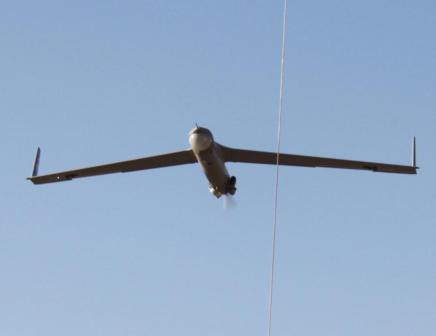
US to provide ScanEagle drones to Ukraine

Air Force secretary tight-lipped about new Phoenix Ghost suicide drone

Pentagon shares new vision to address problems with its microelectronics supply chain
American kamikazes: pentagon has big plans for suicide drones, marine corps commandant gung-ho about loitering munitions, white house wants $550m for new critical munitions acquisition fund, biden sending new drones to ukraine, latest podcasts.

The future of FedRAMP

Exploring the cybersecurity policy landscape
The evolution of hacking 4 defense.
- HHS IT draft strategy aims to connect health data with systems
- Peaceful protests, lawful assembly can’t be sole reason for DOJ facial recognition use under interim policy
- As TSA PreCheck enrollments surge, data shows complaints have followed
- The tech behind the nationwide charging network is top of mind for this Biden official
- How 5G and mobile computing-at-the-edge are revolutionizing DOD’s future
- The power of the cloud to aid service members in their transition to civilian life
- Why ICAM at the edge is critical to enabling mission success
- Federal judge declines to grant DOJ interim injunction in Booz Allen antitrust case
- State Department is launching an internal chatbot
- AI won’t replace cybersecurity workforce, agency leaders say
- Treasury report calls out cyber risks to financial sector fueled by AI
- NASA investigating 2023 theft of astronaut training devices
Acquisition
- Some federal agencies want to make IT security contracting rules simpler to find
- New FedRAMP roadmap details imminent plans for modernization
- GSA working on corrective action plan following OIG report on 'noncompliant' video-conferencing camera purchase
- CIO-SP4 protests in federal claims court prompt extension request for existing vehicle
Big Safari is a United States Air Force program begun in 1952 which provides management, direction, and control of the acquisition, modification, and logistics support for special purpose weapons systems derived from existing aircraft and systems. To that end, the program operates under procurement procedures which allow it in most cases to designate the contractor. The sole-source arrangement that allows the pairing of contractors to specific requirements is paramount to the program's success.
Bibliography
External links.
The program's mission statement begins:
The BIG SAFARI acquisition and sustainment system employs the necessary flexibility to respond to high-priority, dynamic operational requirements for programs that involve a limited number of systems that require a rapid response to changes in the operational environment throughout the life of the system. BIG SAFARI focuses on acquiring, fielding, and sustaining key operational capabilities that otherwise would not be achievable or supportable in the required timeframe. Events and processes are tailored to meet the user's operational and schedule needs.
The program was reconstituted as the BIG SAFARI Systems Group on 23 November 2004 and activated as same on 18 January 2005. It was redesignated as the 645th Aeronautical Systems Group (645 ASG) on 14 July 2006 and is now aligned as the 645th Aeronautical Systems Group (Big Safari) under the 303rd Aeronautical Systems Wing (303 ASW) of the Air Force Materiel Command , [1] although the program itself receives some direction from National Air and Space Intelligence Center (NASIC). [2]
Both the 645 ASG (Big Safari) and 303 ASW are headquartered at Wright-Patterson AFB , although Big Safari also has facilities at Hanscom AFB and Majors Airport in Greenville, Texas . The program oversees, among other aircraft, the RC-135 and EC-130 aircraft as well as unmanned aerial vehicles and remotely piloted aircraft .
The Air Force has referred to Big Safari as a "rapid procurement force," which tests the fielding of new weapons systems, sensors, and platforms. By some accounts, [3] the program has been operating since the late 1950s, when the BQM-34 Firefly drone was procured and evaluated. This effort led to the first operational unmanned reconnaissance vehicle, the redesignated Ryan Aeronautical AQM-34 Lightning Bug . Programs conducted under the auspices of Big Safari are identified by two-word names beginning with the word "Rivet." For instance, the RC-135V and RC-135W model aircraft are part of the "Rivet Joint" program.
The program is still operational as of 6 May, 2022. [4]
Related Research Articles

The Boeing RC-135 is a family of large reconnaissance aircraft built by Boeing and modified by a number of companies, including General Dynamics, Lockheed, LTV, E-Systems, and L3 Technologies, and used by the United States Air Force and Royal Air Force to support theater and national level intelligence consumers with near real-time on-scene collection, analysis and dissemination capabilities.

Beale Air Force Base (AFB) is a United States Air Force base located approximately 8 miles (13 km) east of Marysville, California. It is located outside Linda, about 10 miles (16 km) east of the towns of Marysville and Yuba City, and about 40 miles (64 km) north of Sacramento.

The Lockheed EC-121 Warning Star was an American airborne early warning and control radar surveillance aircraft operational in the 1950s in both the United States Navy (USN) and United States Air Force (USAF).
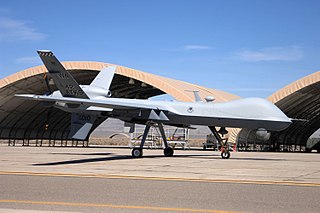
Creech Air Force Base is a United States Air Force (USAF) command and control facility in Clark County, Nevada used "to engage in daily Overseas Contingency Operations …of remotely piloted aircraft systems which fly missions across the globe." In addition to an airport, the military installation has the Unmanned Aerial Vehicle Battlelab, associated aerial warfare ground equipment, and unmanned aerial vehicles of the type used in Afghanistan and Iraq. Creech is the aerial training site for the USAF Thunderbirds and "is one of two emergency divert airfields" for the Nevada Test and Training Range.

The Lockheed DC-130 was a variant of the C-130 Hercules, designed for drone control. It could carry four Ryan Firebee drones underneath its wings.

The Ryan Model 147 Lightning Bug is a jet-powered drone, or unmanned aerial vehicle, produced and developed by Ryan Aeronautical from the earlier Ryan Firebee target drone series.
The usefulness of UAVs for aerial reconnaissance was demonstrated to the United States in the Vietnam War. At the same time, early steps were being taken to use them in active combat at sea and on land, but unmanned combat aerial vehicles would not come into their own until the 1980s.

The 55th Operations Group is a component of the 55th Wing, assigned to the United States Air Force Air Combat Command. The group is stationed at Offut Air Force Base, Nebraska.

The Pakistan Aeronautical Complex , or PAC ) is a major defense contractor and an aerospace manufacturer that is headquartered in Kamra, Punjab, Pakistan.

The 11th Attack Squadron is a United States Air Force unit assigned to the 432d Wing Air Combat Command at Creech Air Force Base near Indian Springs, Nevada. It flies General Atomics MQ-9 Reaper Unmanned aerial vehicles. In 1995 the 11th became the first Remotely Piloted Aircraft (RPA) squadron in the Air Force.

The 303rd Aeronautical Systems Wing was a United States Air Force unit assigned to the Air Force Materiel Command Aeronautical Systems Center, 2005-2010. It was stationed at Wright-Patterson Air Force Base, Ohio as a tenant unit.

The 326th Aeronautical Systems Wing is an inactive wing of the United States Air Force. It was last assigned to the Aeronautical Systems Center at Wright-Patterson Air Force Base, Ohio, where it was inactivated in 2008.

The Aeronautical Systems Center (ASC) is an inactivated Air Force product center that designed, developed and delivered weapon systems and capabilities for U.S. Air Force, other U.S. military, allied and coalition-partner warfighters. ASC managed 420 Air Force, joint and international aircraft acquisition programs and related projects; executed an annual budget of $19 billion and employed a workforce of more than 11,000 people located at Wright-Patterson Air Force base and 38 other locations worldwide. ASC's portfolio included capabilities in fighter/attack, long-range strike, reconnaissance, mobility, agile combat support, special operations forces, training, unmanned aircraft systems, human systems integration and installation support. ASC was deactivated during a July 20, 2012 ceremony held at Wright-Patterson Air Force Base, Ohio.

The 432nd Wing is a United States Air Force unit assigned to Air Combat Command at Creech Air Force Base near Indian Springs, Nevada. It flies General Atomics MQ-9 Reaper and RQ-170 Sentinel Unmanned aerial vehicles.

The Elbit Systems Hermes 900 Kochav ("Star") is an Israeli medium-size, multi-payload, medium-altitude long-endurance unmanned aerial vehicle (UAV) designed for tactical missions. It is a successor to the Hermes 450 series of drones, one of the most widely used military drones in the world.

The Radioplane Q-1 was an American target drone, developed in the early 1950s for the United States Air Force by the Radioplane Company. Originally powered by a pulsejet engine, then later developed as an improved turbojet-powered aircraft, the Q-1 failed to win the favor of the USAF. However, the aircraft provided the basis of the GAM-67 Crossbow anti-radar missile.

The 22d Intelligence Squadron is a non-flying squadron of the United States Air Force. It is assigned to the 691st Intelligence, Surveillance and Reconnaissance Group, Fort George G. Meade, Maryland.

The Martin/General Dynamics RB-57F Canberra is a specialized strategic reconnaissance aircraft developed in the 1960s for the United States Air Force by General Dynamics from the Martin B-57 Canberra tactical bomber, which itself was a license-built version of the English Electric Canberra. It was operationally assigned to the Air Weather Service for weather reconnaissance involving high-altitude atmospheric sampling and radiation detection in support of nuclear test monitoring, but four of the 21 modified aircraft performed solely as strategic reconnaissance platforms in Japan and Germany.

The Fleetwings BQ-2 was an early expendable unmanned aerial vehicle — referred to at the time as an "assault drone" — developed by Fleetwings during the Second World War for use by the United States Army Air Forces. Only a single example of the type was built; the aircraft was deemed too expensive for service and was cancelled after a brief flight testing career.

The Kratos XQ-58 Valkyrie is an experimental stealthy unmanned combat aerial vehicle (UCAV) designed and built by Kratos Defense & Security Solutions for the United States Air Force Low Cost Attritable Strike Demonstrator (LCASD) program, under the USAF Research Laboratory’s Low Cost Attritable Aircraft Technology (LCAAT) project portfolio. It was initially designated the XQ-222 . The Valkyrie successfully completed its first flight on 5 March 2019 at Yuma Proving Ground, Arizona.
- ↑ Air Force Pamphlet 38-102: Manpower and Organization: Headquarters United States Air Force Organization and Functions (PDF) . Washington, DC: Department of the Air Force. 2001.
- ↑ Jonas, Christopher A. (March 1997). "Unmanned Aerial Vehicles (UAVs): An Assessment of Historical Operations and Future Possibilities" (PDF) . Archived from the original (PDF) on 29 September 2011 . Retrieved 18 May 2016 . {{ cite journal }} : Cite journal requires | journal= ( help )
- ↑ Harper, Jon. "New Phoenix Ghost drone was 'Big Safari' project" . Retrieved 10 May 2022 .
- Grimes, Bill, Col. USAF (Ret) (2014). The History of Big Safari . Archway Publishing. ISBN 978-1-4808-0456-2 .
- BIG SAFARI for National Defense Industrial Association (NDIA)
Watch CBS News
Solar eclipse maps show 2024 totality path, peak times and how much of the eclipse people could see across the U.S.
By Aliza Chasan
Updated on: April 9, 2024 / 5:00 AM EDT / CBS News
A total solar eclipse crossed North America Monday with parts of 15 U.S. states within the path of totality. Maps show where and when astronomy fans could see the big event as skies darkened in the middle of the day Monday, April 8.
The total eclipse first appeared along Mexico's Pacific Coast at around 11:07 a.m. PDT, then traveled across a swath of the U.S., from Texas to Maine, and into Canada.
About 31.6 million people live in the path of totality , the area where the moon fully blocked out the sun , according to NASA. The path ranged between 108 and 122 miles wide. An additional 150 million people live within 200 miles of the path of totality.
Solar eclipse path of totality map for 2024

The total solar eclipse started over the Pacific Ocean, and the first location in continental North America that experienced totality was Mexico's Pacific Coast, around 11:07 a.m. PDT, according to NASA. From there, the path continued into Texas, crossing more than a dozen states before the eclipse enters Canada in southern Ontario. The eclipse exited continental North America at around 5:16 p.m. NDT from Newfoundland, Canada.
The path of totality included portions of the following states:
- Pennsylvania
- New Hampshire
Small parts of Tennessee and Michigan also experienced the total solar eclipse.
Several major cities across the U.S. were included in the eclipse's path of totality, while many others saw a partial eclipse. These were some of the best major cities for eclipse viewing — though the weather was a factor :
- San Antonio, Texas (partially under the path)
- Austin, Texas
- Waco, Texas
- Dallas, Texas
- Little Rock, Arkansas
- Indianapolis, Indiana
- Dayton, Ohio
- Cleveland, Ohio
- Buffalo, New York
- Rochester, New York
- Syracuse, New York
- Burlington, Vermont
Map of when the solar eclipse reached totality across its path
The eclipse began in the U.S. as a partial eclipse beginning at 12:06 p.m. CDT near Eagle Pass, Texas, before progressing to totality by about 1:27 p.m. CDT and then moving along its path to the northeast over the following few hours.
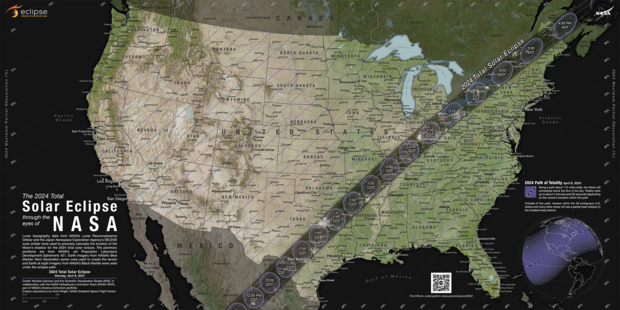
NASA shared times for several cities in the path of totality across the U.S. People could have also checked their ZIP code on NASA's map to see when the eclipse was to reach them if they were on, or near, the path of totality — or if they saw a partial eclipse instead.
How much of the eclipse did people see if they live outside the totality path?
While the April 8 eclipse covered a wide swath of the U.S., outside the path of totality observers may have spotted a partial eclipse, where the moon covers some, but not all, of the sun, according to NASA. The closer they were to the path of totality, the larger the portion of the sun that was hidden.
NASA allowed viewers to input a ZIP code and see how much of the sun was to be covered in their locations.
Could there be cloud cover be during the solar eclipse?
Some areas along the path of totality had a higher likelihood of cloud cover that could interfere with viewing the eclipse. Here is a map showing the historical trends in cloud cover this time of year.
You could have checked the latest forecast for your location with our partners at The Weather Channel .

Where did the solar eclipse reach totality for the longest?
Eclipse viewers near Torreón, Mexico, got to experience totality for the longest. Totality there lasted 4 minutes, 28 seconds, according to NASA.
Most places along the centerline of the path of totality saw a totality duration of between 3.5 and 4 minutes, according to NASA. Some places in the U.S. came close to the maximum; Kerrville, Texas, had a totality duration of 4 minutes, 24 seconds.
What is the path of totality for the 2044 solar eclipse?
The next total solar eclipse that will be visible from the contiguous U.S. will be on Aug. 23, 2044.
Astronomy fans in the U.S. will have far fewer opportunities to see the 2044 eclipse they had on April 8. NASA has not yet made maps available for the 2044 eclipse but, according to The Planetary Society , the path of totality will only touch three states.
The 2024 eclipse will start in Greenland, pass over Canada and end as the sun sets in Montana, North Dakota and South Dakota, according to the Planetary Society.

Aliza Chasan is a digital producer at 60 Minutes and CBSNews.com. She has previously written for outlets including PIX11 News, The New York Daily News, Inside Edition and DNAinfo. Aliza covers trending news, often focusing on crime and politics.
More from CBS News

Bill Nye shares tips for eclipse: "Be in the moment"

Couple gets engaged on flight to see total solar eclipse

Jelly Roll reflects on his path from juvenile detention to CMT Award winner


Severe weather, flooding, possible tornadoes threaten Southeast
Live updates: Everything you need to know about Monday's solar eclipse
The big day has finally arrived − the 2024 solar eclipse will draw millions to look skyward . Thousands have traveled to see it, some even crossing oceans just to catch a glimpse.
So, what final details should you remember as you enjoy the celestial event? Take a look.
Check back throughout the day for live updates from Austin and statewide:
3:40 p.m. The eclipse has left the building
The eclipse ended in the Austin area around 3 p.m., but it will live in our hearts, fond memories and photos that you can purchase forever. If you did happen to glance at the sun and you're worried about eclipse blindness, you can check out the symptoms here. If you're wondering what to with your eclipse glasses, we have suggestions here .
Amazingly, traffic in the Texas capital remains manageable. According to Google, a trip from Zilker Park to the departures gate at Austin Bergstrom is currently only 26 minutes. If you're on your way out of Austin, we hope you've enjoyed your stay. If you're a local, thanks for joining us on this celestial journey and we hope to connect again soon!
2:08 p.m.: Early post-eclipse traffic snarls are not as bad as anticipated
For weeks, we've been preparing for a crush of visitors that would overwhelm Austin roads and turn I-35 into a parking lot. 30 minutes after totality, the roads are looking surprisingly clear. According to Google maps, a trip from the Texas State Capitol to the airport was only 18 minutes. That same trip from Zilker Park is 22 minutes. Travel from the Long Center's eclipse event to Pflugerville was 29 minutes and the same trip up to Cedar Park was 27 minutes.
1:54 p.m. Students and adults at Reilly Elementary danced under the moon-darkened sky
As the day became dark at Reilly Elementary, children and adults alike ran around in glee, cheering the once-in-a-lifetime event.
As the sun again began poking out from behind the moon’s showdown, Bonnie Tyler’s “Total Eclipse of the Heart” rang out from a speaker as students broke into a dance party.
1:47 p.m. Zilker Park erupted in cheers during a brief glance of the ring of fire
Persistent cloud cover didn't deter a crowd of eclipse watchers at Zilker Park who camped on the great lawn and cheered each time the sun peeked out from behind the clouds (and the moon). As the city moved into totality there was a momentary appearance of the full ring as the moon passed over the sun. It was very brief but the full park saw it and erupted into cheers They cheered several times while the ring was visible, when it appeared absolutely darkest and then as orange hues started to illuminate the otherwise very gray sky at the end.
1:35 p.m. Austin, we have hit.....TOTALITY!
Oh snap! It's dark. It's suddenly chilly. Stop reading this right now and look up at the sky! Take a deep breath. Listen for crickets. Think celestial thoughts. Experience the magic. Totality in most of the city will last for less than two minutes.
12:25 p.m.: The eclipse is a 'twice in a lifetime' experience for this family
We caught up with the Schuster family, who traveled from Annapolis, Maryland for the eclipse, at the Texas Capitol.
This is the family's second time traveling for a total solar eclipse, after visiting Columbia, South Carolina in 2017. Addison Schuster turned 21 on the trip to Texas, and the family came to Austin because he had wanted to visit the city for years. They've done some shopping, sampled some Texas BBQ, and made a stop at Dirty Sixth one night.
They are hopeful the eclipse is visible in the next hour, but feel confident there will be noticeable effects no matter what.
12:17 p.m. It's starting! There's sun (sort of)! Go look at the sky!
It's go time, Austin! The solar eclipse will be visible from the Austin area from 12:17 p.m. to 2:58 p.m., with totality from 1:35 p.m. to 1:38 p.m. Not in Austin? Here's more eclipse time information.
11:52 a.m.: Eclipse watchers gather at the Long Center for the city's best skyline view
Twelve thousand people registered to watch the spectacular solar eclipse from the Long Center, but only the first 5,000 will make it onto the Hartman Lawn. Thousands more will spill out along Ladybird Lake and bridges connecting the downtown area. The sun keeps peeking in and out of the light cloud cover as everyone hopes for a clear view of the moon overtaking the sun.
“We keep saying it’s like dramatic effect,” says Cory Baker, the CEO of the Long Center. “I’m hoping it’s gonna burn off and we’re going to have clear skies.”
Tote bags, glasses, pens and journals are given to everyone who enters, not a blade of grass is expected to be seen with wall-to-wall onlookers hoping to catch the natural event.
“(Eclipses) happen every 18 months so it’s not that they’re rare on the planet,” says Ivvet Modinou, the Senior Vice President for Science Society and Culture for the Simons Foundation, “but for it to intersect with the place you call home is very rare.”
Libby Amos, 6, and Emma, 4, posed with their friend Lydia Witherspoon in the frame picture spot overlooking the city.
“It’s very, very, super duper cool,” says Libby who came with her Louisiana family.
“I used to teach eighth grade earth and space science and it was so fun to teach to my students and it’s just so cool to share with my kids now,” says Libby and Emma’s mom Madeline Brown.
The doors opened at 11 a.m. with the Mother Nature spectacular expected at 1:35 p.m.
11:17 a.m.: An estimated 40% of camp sites at Pace Bend Park in Spicewood are unoccupied
Out at Pace Bend Park in Spicewood, there are clouds and campers and also several unoccupied camping sites. Every site that's unoccupied has a Reserved tag on it. It was the same story on Sunday. Where are the campers? Where are the eclipsers?
The primitive corner of Pace Bend's campground is between half- and three-fourths filled. Perhaps it is the threat of clouds, and possibly even rain, during today's eclipse that's keeping the campers away: Pace Bend's sites are all reserved, a camp employee said, but she estimated that 40% of the reserved sites are currently unoccupied.
"Let's manifest sunlight," said one camper earlier this morning.
11:09 a.m.: Texas Eclipse Festival in Burnet canceled due to potential severe weather
The Texas Eclipse Festival in Burnet is ending a day early on Monday due to possible severe weather, including risks of tornadic activity, thunderstorms and large hail, the festival said in online posts.
Festival organizers urged attendees to leave early for safety and to beat traffic. Organizers agreed to end the festival in coordination with Burnet County officials, local safety agencies and the National Weather Service, according to the festival’s website.
All programming and performances for Monday and Tuesday are canceled. No additional guests will be allowed to enter the venue, and inbound shuttles to the venue are canceled. More information .
10:47 a.m.: Crowds are sparser than expected at the bat bridge
Matt Langbehn, from Round Rock, is the first to set up camp near the South Congress bat bridge in Austin. Langbehn said he arrived at 4 a.m. because of expected crowds, but as of 10:40 he was still the lone individual on the hill.
"I wake up early anyway," Langbehn said, undeterred.
"It's been a beautiful day," he added.
10:19 a.m.: Need a professional photo of the eclipse? We've got you
These days, we all walk around with powerful cameras in our pockets. But if you're trying to record the eclipse with your smart phone, you should use a solar filter (except when the eclipse has reached full totality). And honestly, capturing the majesty of an event like the eclipse is a job for the pros.
After the eclipse, we'll have posters and framed prints from Statesman photojournalists available at usatodaystore.com.
9:55 a.m.: Track flight delays
Click here to see flight delay information provided by the Federal Aviation Association.
9:46 a.m.: When do I need to wear eclipse glasses?
Solar eclipse weather forecast in texas.
It remains likely that clouds will impede viewing in Texas of this afternoon's total solar eclipse.
According to the respective National Weather Service offices, forecasts indicate cloudy weather in Austin-San Antonio and Dallas-Fort Worth — the regions in Texas where the total eclipse will be most prominent — during the astronomical event with possible severe thunderstorms for hours immediately following.
Weather forecast: Clouds likely to rain on the solar eclipse parade across Texas on Monday, NWS says
Despite the predicted cloud cover, Bill Nye assures us that Texans will still be able to view the solar eclipse.
More: Bill Nye told us what's going to happen if it's cloudy during total solar eclipse in Texas
Am I in the path of totality?
What time is the eclipse in my area.
Eclipse partiality will begin a little after noon. Totality will start around 1:40 p.m. CST.
- Del Rio: 12:11 p.m. to 2:51 p.m., with totality from 1:28 p.m. to 1:31 p.m.
- San Antonio: 12:14 p.m. to 2:55 p.m., with totality from 1:33 p.m. to 1:34 p.m.
- Austin: 12:17 p.m. to 2:58 p.m., with totality from 1:35 p.m. to 1:38 p.m.
- Dallas: 12:23 p.m. to 3:02 p.m., with totality from 1:40 p.m. to 1:44 p.m.
- Texarkana: 12:28 p.m. to 3:07 p.m., with totality from 1:46 p.m. to 1:49 p.m.
Enter your ZIP code below to see how the eclipse will look in your area and what time you should expect to see totality.
Can't see graphics? Search your ZIP code for a complete eclipse viewing guide
What time is the eclipse across the US?
Solar eclipse map: path of totality in texas.
The map below is based on data from NASA, NOAA and the North Carolina Institute for Climate Studies to show eclipse times, peak sun coverage and likely levels of cloudiness during the solar eclipse April 8.
'New' path of totality map: More parts of Texas will get to see the solar eclipse
Where can I get solar eclipse glasses near me?
Solar eclipse enthusiasts have little time left to get their hands on safe viewing glasses before the celestial phenomenon Monday .
The Statesman turned to the experts at the American Astronomical Society for information on safe eclipse viewing glasses. These retailers, and others, are on their approved list :
- Walmart: Prices start at $9.99. They're available to snag online .
- Lowe's: Eclipse glasses are available in-store only .
- The Home Depot: Sells eclipse glasses , but its stock is very limited and may no longer be available.
- Staples: Purchase a 50-pack of eclipse glasses for $149.50 online .
- More local stores: Buc-ee's , Cracker Barrel and Kroger .
Is your local store out of glasses? Check out this map of stores by Linq that still have them in stock
When buying eclipse viewing glasses, make sure they are certified by the International Organization for Standardization and have the "ISO" icon. The glasses should also have the ISO reference number: 12312-2.
Solar eclipse road closures in Texas
Roads are expected to have 30% more drivers than usual today and tomorrow, according to CBS News . Traffic will also be more congested in the path of totality and surrounding areas.
The Texas Department of Motor Vehicles has banned overweight and/or oversized loads from a large swath of highways today.
Despite some anxiety regarding the implications of the road ban, the department assures this will not affect major transportation such as grocery distribution and mail delivery.
"Route restrictions are a regular part of the oversize/overweight permitting process for various reasons," a DMV spokesperson told MySA . "But a total eclipse is, of course, not a common reason."
The Texas Department of Transportation has also been proactive in making roads as safe as possible.
"Solar eclipse Monday, delays possible," TxDOT's electronic billboards read. "Arrive early, stay put, leave late."
People are also reading: Driving to see the solar eclipse? These Texas roads may see the most traffic
Click here to see TxDOT's total guide for Texas eclipse travel.
The department has also shared the following safe driving tips:
- Expect heavy traffic in the days before and during the solar eclipse.
- Plan to leave early and stay late. Use DriveTexas.org to see live traffic conditions.
- Do not park in the middle of roads or on road shoulders. Find a safe place to park to view the eclipse.
- Keep your headlights on, even in daylight.
- Do not wear eclipse viewing glasses while driving.
- Skip to main content
- Keyboard shortcuts for audio player

Solar eclipse 2024: Follow the path of totality
Solar eclipse, what you need to know to watch monday's total solar eclipse.
The NPR Network
A stunning celestial event is visible across the country Monday, when the moon crosses directly in front of the sun: a total solar eclipse. For those in the path of totality, there will be a few brief moments when the moon completely covers the sun and the world becomes dark.
Traveling for totality? Skip ahead.
This will be the last chance to catch a total solar eclipse in the continental U.S. for about 20 years, so here's what you need to know to safely enjoy!
When is the eclipse?
April 8, 2024 there will be a total solar eclipse that crosses from the Pacific coast of Mexico through the United States.
What is totality and why it matters
According to NASA , totality will start around 11:07 a.m. PDT/1:07 EDT in Mexico and leave Maine at around 1:30 pm PDT/3:30 pm EDT.

Here's what time the eclipse will be visible in your region
Check out this table for when the partial eclipse and totality are visible in each region or check by zip code here.
A partial solar eclipse will be visible across the contiguous United States, so even if you're not directly in the path, you should be able to see something special, weather permitting.
Unable to get to totality? We'll be sharing highlights here from across the NPR Network throughout the day Monday if you can't see it in real time.
Where to see totality?
More than 30 million people live in the path of totality for Monday's eclipse, and many more in nearby areas.
Here's what we know about Monday's weather forecast.
Why totality matters
As NPR's Neil Greenfieldboyce explains , "During a total eclipse, the sky darkens suddenly and dramatically . The temperature drops. Stars come out. Beautiful colors appear around the horizon. And the once-familiar sun becomes a black void in the sky surrounded by the glowing corona — that's the ghostly white ring that is the sun's atmosphere."

Eclipse Science
For april's eclipse, going from 'meh' to 'omg' might mean just driving across town.
A partial eclipse, while still a fun experience, is hardly as dramatic. Those with a view of the partial eclipse will see crescent-shaped shadows like those seen here in 2017.
How to watch safely
If you plan to look directly at the eclipse (partial or totality), you're going to need eclipse glasses handy because looking directly at the sun without proper protection ( traditional sunglasses don't count! ) can be harmful to your eyes.

The perfect celestial soundtrack to the total solar eclipse
As NPR's Joe Hernandez explains, "Proper eye protection must be worn throughout a total solar eclipse — except for the roughly 3 1/2 to 4 minutes when the moon fully obscures the sun, a brief period known as 'totality.' (You will need to take your glasses off during totality to actually see it.)"
If you don't have access to eclipse glasses, you can get crafty with things you have around the house ( like some of us did back in 2017!) More on that here.
Traveling for totality?
The celestial event is driving a ton of domestic travel to the path of totality. If you're headed out of town to view the eclipse, here are some NPR Network resources for areas in the path of totality:
Texas The path of totality crosses through the Lone Star State, with some areas expecting a possible influx of visitors in the hundreds of thousands to catch prime viewing. Our member stations across the state have gathered local resources to help you navigate the region and the eclipse!
- San Antonio: Check out the latest from Texas Public Radio
- Dallas: Explore KERA's coverage for the latest
- Austin: Head to KUT for the best local resources
Arkansas The eclipse will be cutting through the state, putting Little Rock in the path of totality. Check out Little Rock Public Radio for local resources.
The southwestern edge of the state will be well-positioned to witness the total solar eclipse this year. Kentucky Public Radio is covering the eclipse throughout the region, from Kentuckiana eclipse mania to the University of Louisville's free class about the celestial event. Keep an eye on WKMS for the latest local updates.
Missouri The southeastern corner of the state will be in the path of totality, crossing across towns like Whitewater and Ste. Genevieve. Head to St. Louis Public Radio for local coverage and resources. Illinois Carbondale seems to have won the eclipse lottery, being in the path of totality both in 2017 and for this year's eclipse . For resources from across the state, check out Illinois Public Media .
Indiana A huge portion of the state will be within the path of totality, giving cities across Indiana, including Bloomington and Indianapolis, prime viewing of the eclipse.
- Bloomington: Check out Indiana Public Media
- Indianapolis: Head to WFYI for the latest
- Fort Wayne: Just north of the path of totality, WBOI has resources for the Allen County area
Ohio The Buckeye State is getting bisected by this year's path of totality, plunging a number of the state's most populous areas into darkness for a few minutes on Monday.
- Cleveland: Head to Ideastream Public Media for the latest.
- Columbus: With the capital city just south of totality, head to WOSU for regional resources.
- Cincinnati: Totality will just miss the border town. Here are some tips from WVXU on how to navigate the eclipse in the region.
Pennsylvania Only the northwestern-most corner of the state will catch totality, with views from the lakeside in Erie being particularly well-positioned for a stunning viewing experience. WESA has more from across the region.

Plan to watch the eclipse from a wild mountain summit? Be ready for harsh conditions
New York Buffalo, Rochester, Syracuse and Plattsburgh will fall under the path of totality on Monday. If you're planning to travel to the region for the best views, here are some local resources to stay safe and informed:
- Buffalo: Head to WBFO for the latest
- Syracuse: WAER has more on plans in the Salt City
- North Country: NCPR has the latest from across the region, as well as information on local viewing events to check out
Vermont The Green Mountain State will see totality across its most populous region, including Burlington and Montpelier, as well as the Northeast Kingdom on the Canadian border. Vermont Public has everything you need to know to navigate your time in the region to enjoy the eclipse safely. New Hampshire The northernmost region of the Granite State will be in the path of totality, providing prime viewing to those in Coos County. NHPR has info on local events, travel updates as well as special coverage with New Hampshire Public Television. Maine The last state in the path of totality in the U.S., much of Northern Maine will be positioned for prime viewing. The rural region is preparing for an influx of visitors, and safety officials are encouraging visitors and locals alike to be prepared. Maine Public will be covering the eclipse and has everything you need to know to navigate the region safely.
How to document the eclipse safely
With the ease of cell photography , it can be tempting to reach for your phone to document the eclipse and the moments of totality, but make sure to do so safely.
As NPR's Scott Neuman explains , "For starters, you'll need to wear eclipse glasses or similar protective eye gear while aiming your camera or even just observing the eclipse."
Feeling ambitious? Here are a few more tips.
Or if you're not inclined to capture the moment visually, you lean into some other forms of creative expression. Indiana, for example, has named Linda Neal Reising the official poet in the state for this year's eclipse.
As former NPR reporter and eclipse superfan David Baron shared with Life Kit , viewing totality "[is] like you've left the solar system and are looking back from some other world."
So consider focusing on being present in the moment to enjoy the celestial spectacle.
More resources to enjoy the eclipse
- Sharing the eclipse with tiny humans? Check out these kid-friendly total solar eclipse learning guides from Vermont Public's But Why, and this great explainer from KERA Kids on the difference between a solar and a lunar eclipse.
- Want to see how a solar eclipse alters colors? Wear red and green on Monday
- Plan to wander into the wild for the best view? Here are some tips from outdoor experts.
- Tips from Bill Nye on the best ways to enjoy the eclipse.
NPR will be sharing highlights here from across the NPR Network throughout the day Monday if you're unable to get out and see it in real time. NPR's Emily Alfin Johnson compiled these resources.
- 2024 eclipse
Looking to buy solar eclipse glasses last-minute? Here are 4 large retailers selling them

As we enter the week before the 2024 solar eclipse, Texans are making some last-minute preparations. From booking hotel rooms, planning gatherings, and checking out a new path of totality, it's a busy time to live in Texas.
Just don't forget the most important solar eclipse essential: solar eclipse glasses.
People are also reading: 'New' path of totality map shows more parts of Texas will get to see the solar eclipse
While the majority of free glasses may be gone, there are still stores selling protective eyewear. Here's a breakdown:
Where to buy solar eclipse glasses
The American Astronomical Society has published guidelines for safely viewing the April 8 solar eclipse.
The society recommends that people make sure that the seller is identified on the site they are using and is included in its list before buying a solar viewer or filter online.
People are also reading: Here's how to get free solar eclipse glasses in Texas and how to know they're safe
Here are a few large chains selling solar eclipse glasses.
As you may have guessed, retail giant Walmart has a variety of solar eclipse eye protection. From glasses to telescope filters to eclipse-themed clothing, there's something for everyone.
Office supply store Staples is selling solar eclipse glasses for $2.99 each, while supplies last. The glasses are manufactured by American Paper Optics, LLC and feature premium eclipse filters that are ISO 12312-2 compliant, CE certified, and safe for all phases of the eclipse.
Staples stores are also stocked with travel necessities such as TSA PreCheck enrollment, travel accessories, luggage essentials and more.
Home improvement retail chain The Home Depot is offering glasses manufactured by Executive Image LLC, along with some higher quality glasses.
In addition to eye protection, The Home Depot has a selection of binoculars with ISO-certified, Solar Safe filter technology.
Another home improvement chain is selling affordable solar eclipse glasses. Lowes has a handful of eye protection products to choose from.
Other stores to look for solar glasses:
- Cracker Barrel
How to know if solar eclipse glasses are safe
Guidelines for safely viewing the solar eclipse can be found on the American Astronomical Society’s site .
If you buy eclipse glasses, be sure they are made by companies the American Astronomical Society and NASA have certified as safe for use. They should all have the "ISO" (International Organization for Standardization) icon. The glasses also must have the ISO reference number 12312-2.
How to make solar eclipse viewers at home
Materials for a pinhole projector :
- A cardboard box
- White paper
- Aluminum foil
You can even use a kitchen colander to view the eclipse by looking at the shadow the colander casts on a piece of paper.
Where to buy solar eclipse glasses near me? Some locations may still have glasses for last-minute eclipse watchers

Today's the day when the moon's shadow will (partially) blot out the sun for millions of Floridians, and some of them may still be scrambling for eclipse glasses so they can safely look at it without frying their eyes. Where can you still find them?
You may have to call around, or do some driving. Many retail locations have been selling solar eclipse glasses this year and some places have been giving them away, but availability is "while supplies last" and that will be different for every place.
There's an eclipse today? The procrastinator's guide to viewing the solar eclipse in Florida
Where can I find eclipse glasses?
Here are some places to check. Remember, some may have sold out, and not all locations may have been carrying them. Make sure any eclipse glasses you buy are legitimate and include an ISO rating, an ISO number and an address, avoid any that say "NASA Approved," and test them before you look up .
7-Eleven, Buc-ee's, Circle K and more
You may not have to go farther than the end of your street. Many convenience stores and gas stations have been carrying eclipse glasses and may still have some in stock.
Eclipse glasses have been spotted at 7-Eleven , Circle K, and Buc-ee's locations and many individual stores may have jumped on the opportunity.
Fake eclipse glases on sale online: Are yours safe? How to test before the April solar eclipse
Big chain stores such as Walmart, Lowes
Walmart has offered a wide variety of eclipse glasses in different styles, so has Target . However, all of the glasses on their websites are shipping only which will be a little late, so check your local store for availability.
Some other places where eclipse glasses have been spotted:
- Ace Hardware
- Cracker Barrel
Does Publix have eclipse glasses?
No, Publix did not carry eclipse glasses this year, according to a local customer service rep.
Warby Parker, Sonic offering free eclipse glasses
Prescription eyeglasses retailer Warby Parker began handing out free eclipse glasses at their locations on April 1 so definitely call first.
Sonic Drive-in locations are offering free eclipse glasses with the purchase of their new Blackout Sonic Float.
Does Amazon offer same-day delivery of eclipse glasses?
Online stores are great for fast service, but you may want to give it a miss this time. The American Astronomical Society (AAS) does not recommend buying eclipse glasses online due to the number of counterfeit, unsafe glasses that have hit the market this year.
Shooting the eclipse with your phone: Can I take a photo of the eclipse with my phone? Yes, but take these steps so you don't fry it
Do I need to wear solar eclipse glasses?
If you plan to look directly at the sun, yes. Even a brief glance may cause temporary or permanent damage to your eyes and eyesight.
"Do NOT look at the Sun through a camera lens, telescope, binoculars, or any other optical device while wearing eclipse glasses or using a handheld solar viewer," NASA advises . "The concentrated solar rays will burn through the filter and cause serious eye injury."
How can I tell if my eclipse glasses are legitimate?
If you didn't buy your eclipse glasses directly from one of the vetted venders on the AAS list or a trusted source, check the text on the glasses for the ISO 12312-2 standard listing and the address of the company. But these can be copied.
Don't trust any glasses that say they are NASA Approved . NASA doesn't do that.
Test your glasses first by putting them on inside and looking at a strong light source. You shouldn't be able to see anything, according to the AAS, although very bright lights may show up but would be very faint.
Go outside, put them on, and look at sunlight reflections or glance at the sun very quickly. You shouldn't see anything around you and the sun should appear to be a "sharp-edged, round disk" that's comfortably bright.
Can I watch the eclipse without looking at it?
Yes! If you don't manage to get glasses in time, there are several ways to see the eclipse that won't risk your eyes with items you probably have around the home.
Anything with a round hole in it can be held up to cast an image of the eclipse onto the ground or a sheet of white paper. Pinhole projectors, colanders, a slotted spoon, a Ritz cracker, even lacing your fingers together.
Or you can look under a tree. The sun shining through tree leaves and branches creates its own pinhole projector, casting lots of little crescent-moon shapes on the ground.
What time is the eclipse in Florida?
The eclipse will last roughly 2½ hours in Florida, starting around 1:40 p.m. EDT and ending around 4:17 EDT. The time of maximum coverage will be just before 3 p.m. EDT for most of the state.
You can find eclipse times for your ZIP code on the map below, just tap your location:
When and where the solar eclipse will be crossing the U.S.
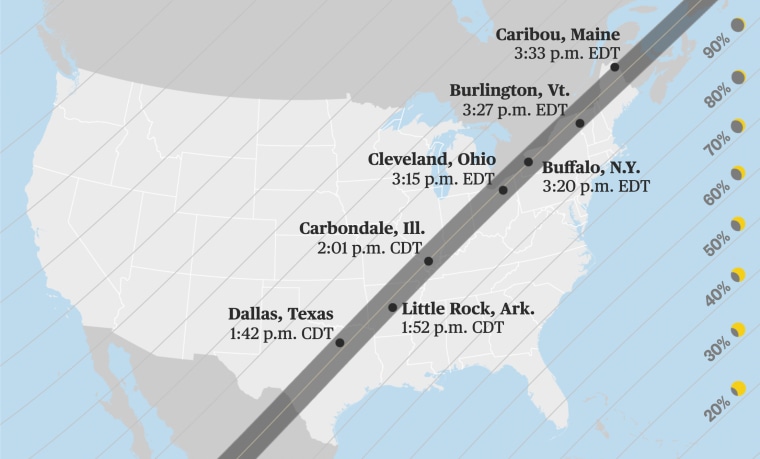
A total solar eclipse will grace the skies over North America on Monday, one of the most hotly anticipated sky-watching events in recent years.
Weather permitting , millions of people in Mexico, 15 U.S. states and eastern Canada will have the chance to see the moon slip between Earth and sun, temporarily blocking the sun’s light .
The total solar eclipse will be visible along a “path of totality” that measures more than 100 miles wide and extends across the continent. Along that path, the moon will fully obscure the sun, causing afternoon skies to darken for a few minutes.
Follow live updates on the solar eclipse
In all other parts of the continental U.S., a partial solar eclipse will be visible, with the moon appearing to take a bite out of the sun. Exactly how big a bite depends on the location.
The first spot in North America that will experience totality on Monday is on Mexico’s Pacific coast at around 11:07 a.m. PT, according to NASA .
After moving northeast across Mexico, the eclipse’s path travels through Texas, Oklahoma, Arkansas, Missouri, Illinois, Kentucky, Indiana, Ohio, Pennsylvania, New York, Vermont, New Hampshire and Maine. Slivers of Michigan and Tennessee will also be able to witness totality if conditions are clear.
In Canada, the eclipse will be visible in parts of southern Ontario, Quebec, New Brunswick, Prince Edward Island and Cape Breton, at the eastern end of Nova Scotia.
The timing of the eclipse and the duration of totality varies by location. Most places will experience around 2 minutes of darkness, but the longest periods of totality are typically in the center of the eclipse’s path.
This year, the longest stretch of totality will last 4 minutes and 28 seconds in an area northwest of Torreón, Mexico.

Below is a list of timings for some U.S. cities along the path of totality, according to NASA .
- Dallas: Partial eclipse begins at 12:23 p.m. CT and totality at 1:40 p.m. CT.
- Idabel, Oklahoma: Partial eclipse begins at 12:28 p.m. CT and totality at 1:45 p.m. CT.
- Little Rock, Arkansas: Partial eclipse begins at 12:33 p.m. CT and totality at 1:51 p.m. CT.
- Poplar Bluff, Missouri: Partial eclipse begins at 12:39 p.m. CT and totality at 1:56 p.m. CT.
- Paducah, Kentucky: Partial eclipse begins at 12:42 p.m. CT and totality at 2:00 p.m. CT.
- Carbondale, Illinois: Partial eclipse begins at 12:42 p.m. CT and totality at 1:59 p.m. CT.
- Evansville, Indiana: Partial eclipse begins at 12:45 p.m. CT and totality at 2:02 p.m. CT.
- Cleveland: Partial eclipse begins at 1:59 p.m. ET and totality at 3:13 p.m.
- Erie, Pennsylvania: Partial eclipse begins at 2:02 p.m. ET and totality at 3:16 p.m. ET.
- Buffalo, New York: Partial eclipse begins at 2:04 p.m. ET and totality at 3:18 p.m.
- Burlington, Vermont: Partial eclipse begins at 2:14 p.m. ET and totality at 3:26 p.m. ET.
- Lancaster, New Hampshire: Partial eclipse begins at 2:16 p.m. ET and totality at 3:27 p.m.
- Caribou, Maine: Partial eclipse begins at 2:22 p.m. ET and totality at 3:32 p.m. ET.
Other resources can also help you figure out when the various phases of the eclipse will be visible where you live, including NationalEclipse.com and TimeandDate.com .
If you plan to watch the celestial event, remember that it’s never safe to look directly at the sun, including through binoculars, telescopes or camera lenses. Special eclipse glasses are required to safely view solar eclipses and prevent permanent eye damage.
Denise Chow is a reporter for NBC News Science focused on general science and climate change.

IMAGES
COMMENTS
Both the 645 ASG (Big Safari) and 303 ASW are headquartered at Wright-Patterson AFB, although Big Safari also has facilities at Hanscom AFB and Majors Airport in Greenville, Texas. The program oversees, among other aircraft, the RC-135 and EC-130 aircraft as well as unmanned aerial vehicles and remotely piloted aircraft.
News. On February 14, a USAF -operated Boeing TC-135W (serial 62-4133) departed Offutt Air Force Base (AFB), Nebraska, for Greenville-Majors Airport, Texas, where it will be reassigned to the air arm's Big Safari Program and redesignated as an NC-135 platform. The aircraft was flown to Texas by members of the 238th Combat Training Squadron ...
The Big Safari program was a Cold War effort to streamline acquisition of special aircraft. The program recently has come under scrutiny. ... The aircraft initially was an unmodified KC-135 which underwent extensive upgrades at the Big Safari facility in Texas ... pictured here in Greenville Texas. (King Hawes, Team-2 Rivet Ball)
Although the "Big Safari" programme office covers multiple Intelligence, Surveillance, and Reconnaissance (ISR) and Special Operations Forces (SOF) projects, Scramble Magazine can now provide an overview of its smaller, mainly white "civil coloured" aircraft. Over the past few years, Scramble has noted, through various sources, less than a handful of those rare aircraft operating in and over ...
WC-135R Constant Phoenix tail number 64-14836 taxis in after arriving at the Lincoln Airport July 11, 2022. Originally delivered to the Air Force in 1964, the aircraft was modified to a WC-135R in Greenville, Texas, by the 645th Aeronautical Systems Group, better known as Big Safari. (U.S. Air Force Photo by Ryan Hansen)
It was later modified to WC-135B/W-standard to undertake weather reconnaissance operations, before the aircraft assumed its current NC-135W designation for the Big Safari mission in 1999. The NC-135W has been replaced in the Big Safari role by a single TC-135W (62-4133), which arrived at the L3Harris facility in Greenville in February 2023.
130 Overton Court. Thousand Oaks , California. United States 91360. Building: Gilbert Sports and Fitness Center, 2nd Floor. Room Number: 253. Contact Event Host. LMAG - Big Safari - US Air Force Fast Intervention Program, 15 February 2018 06:30 PM to 08:30 PM (US/Pacific), Location: CLU, 130 Overton Court, Thousand Oaks , California, United States.
Photo Details / Download Hi-Res. Lineage. Constituted BIG SAFARI Systems Group on 23 Nov 2004. Activated on 18 Jan 2005. Redesignated 645 Aeronautical Systems Group on 14 Jul 2006. Assignments. Reconnaissance (later, 303 Aeronautical) Systems Wing, 18 Jan 2005-. Stations.
07 Feb 1942 (ISR & SOF Dir.—Big Safari) The US Army Air Forces leased the new municipal airport in Greenville, TX, dubbing it Majors Field, as a pilot training facility, including for the WASPs. The base closed after the war and was acquired by the Texas Engineering and Manufacturing Company (TEMCO) in 1951.
Greenville, Texas 88 followers Follow Report this company About us Website ... Big Safari Association | 88 followers on LinkedIn. Skip to main content LinkedIn.
Big Safari is a United States Air Force program which provides management, direction, and control of the acquisition, modification, and logistics support for special purpose weapons systems. The program itself receives some direction from National Air and Space Intelligence Center (NASIC). It is headquartered in Wright-Patterson AFB and has facilities at Hanscom AFB and Greenville, Texas. The ...
The rare Big Safari returning home to Greenville from Offutt AFB. 61-2666. Boeing NC-135W Big Safari. ... USA - Texas; Photographer; Garrett Heller; Photos | Profile | Contact; Ben Suskind 61-2666. 4,273 20 0 Boeing NC-135W Big Safari. The one of a kind NC-135W Big Safari operated by 645th MATS Det.
He has a building named after him, "Camp Grimes" in Greenville, Texas, received a "Peace Mate" award from the Royal Australian Air Force, was honored as the first inductee into the Big Safari Hall of Honor in San Antonio, Texas and earned one of his most treasured awards, being named an honorary Air Force Chief Master Sergeant.
The Boeing RC-135 is a family of large reconnaissance aircraft built by Boeing and modified by a number of companies, including General Dynamics, Lockheed, LTV, E-Systems, and L3 Technologies, and used by the United States Air Force and Royal Air Force to support theater and national level intelligence consumers with near real-time on-scene collection, analysis and dissemination capabilities.
although Big Safari also has facilities at Hanscom AFB and Majors Airport in Greenville, Texas. The program oversees, among other aircraft, the RC-135 and EC-130 aircraft as well as unmanned aerial vehicles and remotely piloted aircraft. The Air Force has referred to Big Safari as a 'rapid procurement force,' which tests the fielding of
For more than half a century, Big Safari-modified aircraft have performed dangerous and essential missions to collect intelligence, conduct surveillance and reconnaissance, and engage in special operations missions around the globe in the interest of national security. These state-of-the-art aircraft have been flown, operated, and maintained by men and women whose dedication and commitment ...
The new Phoenix Ghost suicide drone that the U.S. is supplying to Ukraine was a project overseen by a secretive Air Force office known as Big Safari, the Pentagon's top weapons buyer revealed Friday.. The Biden administration on April 21 publicly revealed the system's existence when it announced that it planned to send more than 120 of them to Ukraine as part of a broader security ...
Both the 645 ASG (Big Safari) and 303 ASW are headquartered at Wright-Patterson AFB, although Big Safari also has facilities at Hanscom AFB and Majors Airport in Greenville, Texas. The program oversees, among other aircraft, the RC-135 and EC-130 aircraft as well as unmanned aerial vehicles and remotely piloted aircraft.
USAF's Big Safari Program receives TC-135W, prepares to divest last NC-135W. On February 14, a USAF-operated Boeing TC-135W departed Offutt AFB, Nebraska, for Greenville-Majors Airport, Texas, where it will be reassigned to the air arm's Big Safari Program and redesignated as...
About Big Safari Association. Big Safari Association is located at Po Box 6056 in Greenville, Texas 75403. Big Safari Association can be contacted via phone at (903) 457-4056 for pricing, hours and directions.
The eclipse will begin in Mexico at about 11:07 a.m. PDT, Monday, April 8 before crossing into Texas at 1:27 p.m. CDT. It will end in Maine at 3:35 p.m. EDT. Even if you're not in the path of ...
A total solar eclipse crosses North America today, with parts of 15 U.S. states within the path of totality. Maps show where and when astronomy fans can see the big event as skies darken in the ...
Check back throughout the day for live updates from Austin and statewide: 3:40 p.m. The eclipse has left the building. The eclipse ended in the Austin area around 3 p.m., but it will live in our ...
Over 30 million people will be within the path of totality for Monday's solar eclipse as it crosses the U.S. from Texas to Maine. Here's what you need to know to safely enjoy the celestial spectacle.
Big Safari.this RC-135 systems test aircraft came to mildenhall for star navigation tests. 645th MTS,Greenville ,Texas. First picture in database.. 61-2666. Boeing NC-135W Big Safari. JetPhotos.com is the biggest database of aviation photographs with over 5 million screened photos online!
Staples. Office supply store Staples is selling solar eclipse glasses for $2.99 each, while supplies last. The glasses are manufactured by American Paper Optics, LLC and feature premium eclipse ...
Many convenience stores and gas stations have been carrying eclipse glasses and may still have some in stock. Eclipse glasses have been spotted at 7-Eleven, Circle K, and Buc-ee's locations and ...
Album Like Share. Note: The one of a kind NC-135W Big Safari operated by 645th MATS Det.2 / L-3 Communications arrives back to its home base. Airline: United States - US Air Force (USAF) Reg: 61-2666 photos. Aircraft: Boeing NC-135W Big Safari. Serial #: 18342. Photo date: 2020-05-18. Uploaded: 2022-05-17. Likes: 7.
Timothy D. Easley / AP file. Below is a list of timings for some U.S. cities along the path of totality, according to NASA. Dallas: Partial eclipse begins at 12:23 p.m. CT and totality at 1:40 p.m ...